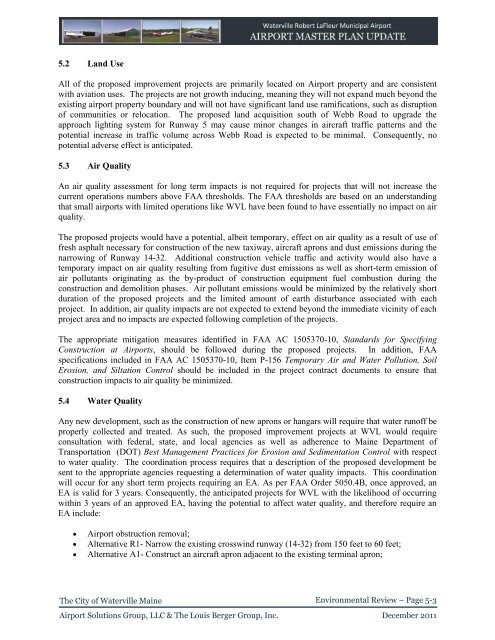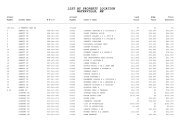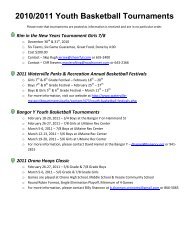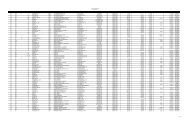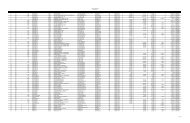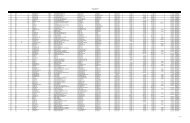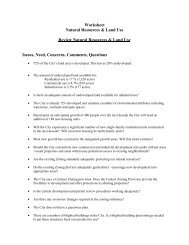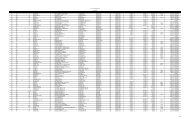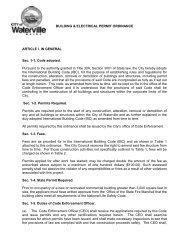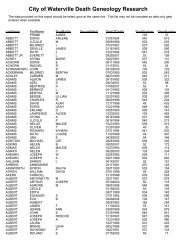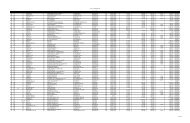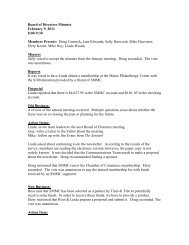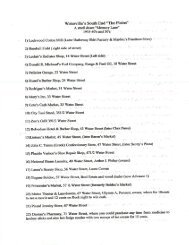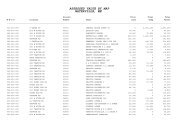Airport Master Plan 2012 - City of Waterville
Airport Master Plan 2012 - City of Waterville
Airport Master Plan 2012 - City of Waterville
You also want an ePaper? Increase the reach of your titles
YUMPU automatically turns print PDFs into web optimized ePapers that Google loves.
5.2 Land Use<br />
All <strong>of</strong> the proposed improvement projects are primarily located on <strong>Airport</strong> property and are consistent<br />
with aviation uses. The projects are not growth inducing, meaning they will not expand much beyond the<br />
existing airport property boundary and will not have significant land use ramifications, such as disruption<br />
<strong>of</strong> communities or relocation. The proposed land acquisition south <strong>of</strong> Webb Road to upgrade the<br />
approach lighting system for Runway 5 may cause minor changes in aircraft traffic patterns and the<br />
potential increase in traffic volume across Webb Road is expected to be minimal. Consequently, no<br />
potential adverse effect is anticipated.<br />
5.3 Air Quality<br />
An air quality assessment for long term impacts is not required for projects that will not increase the<br />
current operations numbers above FAA thresholds. The FAA thresholds are based on an understanding<br />
that small airports with limited operations like WVL have been found to have essentially no impact on air<br />
quality.<br />
The proposed projects would have a potential, albeit temporary, effect on air quality as a result <strong>of</strong> use <strong>of</strong><br />
fresh asphalt necessary for construction <strong>of</strong> the new taxiway, aircraft aprons and dust emissions during the<br />
narrowing <strong>of</strong> Runway 14-32. Additional construction vehicle traffic and activity would also have a<br />
temporary impact on air quality resulting from fugitive dust emissions as well as short-term emission <strong>of</strong><br />
air pollutants originating as the by-product <strong>of</strong> construction equipment fuel combustion during the<br />
construction and demolition phases. Air pollutant emissions would be minimized by the relatively short<br />
duration <strong>of</strong> the proposed projects and the limited amount <strong>of</strong> earth disturbance associated with each<br />
project. In addition, air quality impacts are not expected to extend beyond the immediate vicinity <strong>of</strong> each<br />
project area and no impacts are expected following completion <strong>of</strong> the projects.<br />
The appropriate mitigation measures identified in FAA AC 1505370-10, Standards for Specifying<br />
Construction at <strong>Airport</strong>s, should be followed during the proposed projects. In addition, FAA<br />
specifications included in FAA AC 1505370-10, Item P-156 Temporary Air and Water Pollution, Soil<br />
Erosion, and Siltation Control should be included in the project contract documents to ensure that<br />
construction impacts to air quality be minimized.<br />
5.4 Water Quality<br />
Any new development, such as the construction <strong>of</strong> new aprons or hangars will require that water run<strong>of</strong>f be<br />
properly collected and treated. As such, the proposed improvement projects at WVL would require<br />
consultation with federal, state, and local agencies as well as adherence to Maine Department <strong>of</strong><br />
Transportation (DOT) Best Management Practices for Erosion and Sedimentation Control with respect<br />
to water quality. The coordination process requires that a description <strong>of</strong> the proposed development be<br />
sent to the appropriate agencies requesting a determination <strong>of</strong> water quality impacts. This coordination<br />
will occur for any short term projects requiring an EA. As per FAA Order 5050.4B, once approved, an<br />
EA is valid for 3 years. Consequently, the anticipated projects for WVL with the likelihood <strong>of</strong> occurring<br />
within 3 years <strong>of</strong> an approved EA, having the potential to affect water quality, and therefore require an<br />
EA include:<br />
<br />
<br />
<br />
<strong>Airport</strong> obstruction removal;<br />
Alternative R1- Narrow the existing crosswind runway (14-32) from 150 feet to 60 feet;<br />
Alternative A1- Construct an aircraft apron adjacent to the existing terminal apron;<br />
The <strong>City</strong> <strong>of</strong> <strong>Waterville</strong> Maine<br />
Environmental Review – Page 5-3<br />
<strong>Airport</strong> Solutions Group, LLC & The Louis Berger Group, Inc. December 2011


